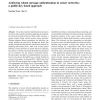120
click to vote
IJISEC
2010
14 years 10 months ago
2010
We propose a generalization of Paillier's probabilistic public key system, in which the expansion factor is reduced and which allows to adjust the block length of the scheme e...
129
Voted
CCS
2010
ACM
14 years 10 months ago
2010
ACM
Numerous applications in ad hoc networks, peer-to-peer networks, and on-the-fly data sharing call for confidential broadcast without relying on a dealer. To cater for such applica...
113
Voted
EUROPKI
2009
Springer
14 years 10 months ago
2009
Springer
Abstract. An electronic signature is considered to be valid, if the signature is mathematically correct and if the signer's public key is classified as authentic. While the fi...
113
Voted
INDOCRYPT
2010
Springer
14 years 10 months ago
2010
Springer
Multivariate Cryptography is one of the alternatives to guarantee the security of communication in the post-quantum world. One major drawback of such schemes is the huge size of th...
116
click to vote
FOCS
2010
IEEE
14 years 10 months ago
2010
IEEE
A fundamental question in leakage-resilient cryptography is: can leakage resilience always be amplified by parallel repetition? It is natural to expect that if we have a leakage-r...
124
Voted
WINET
2010
14 years 11 months ago
2010
Given the extremely limited hardware resources on sensor nodes and the inclement deploying environment, the adversary Denial-of-Service (DoS) attack becomes a serious security thre...
123
click to vote
JCS
2010
14 years 11 months ago
2010
Public-key cryptography can uniquely enable trust within distributed settings. Employing it usually requires deploying a set of tools and services collectively known as a public k...
124
Voted
IDTRUST
2010
ACM
14 years 11 months ago
2010
ACM
Public Key technology is about multiple parties across different domains making assertions that can be chained together to make trust judgments. Today, the need for more interoper...
111
click to vote
COMCOM
1999
15 years 11 days ago
1999
Certificate policies play a central role in public key infrastructures, since they are the basis for the evaluation of trust in binding between a key and a subject in a public key...
104
Voted
DCC
2000
IEEE
15 years 16 days ago
2000
IEEE
The first practical public key cryptosystem to be published, the Diffie-Hellman key exchange algorithm, was based on the assumption that discrete logarithms are hard to compute. T...




